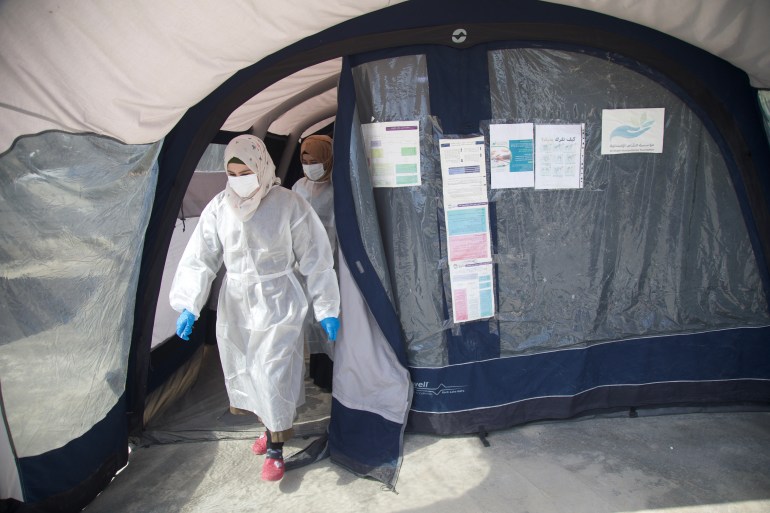Idlib, Syria – Abdel Moneim Hamdo rushed his two children, one a toddler, to a hospital in the northwest Syrian city of Idlib after they complained of severe stomach aches that did not seem to resolve.
“I took my son and daughter to hospital to check whether they’d contracted cholera,” said Hamdo. He and his family — including his eight children — had moved from Atarib near Aleppo to the Al-Iman camp, close to Idlib, following the devastating earthquakes that struck the Turkey-Syria border region in February.
“But after doing some tests, it turned out they were suffering acute gastroenteritis as a result of consuming contaminated water,” he said, adding that necessities, including access to clean water and sanitary toilet facilities, were lacking at the camp.
Millions of Syrians were already displaced by more than 11 years of war, and the difficult living conditions at refugee camps in the area have worsened since the earthquakes. The number of people getting infected with cholera — a disease caused by eating and drinking contaminated food or water — has been on the rise.
And there are concerns that the camp lacks enough resources to handle an outbreak.
“After we survived the earthquake, we are now living in fear of contracting any of the communicable diseases that are spreading like wildfire across the camps,” said Hamdo, whose house collapsed in the February 6 earthquakes. “It’s as if we’ve escaped death only to find death.”
Growing numbers
At least two people died of cholera in northwestern Syria last month, while the total number of cholera deaths recorded in the northwest since the outbreak began last year rose to 22, according to a tweet earlier this week from the Syria Civil Defence, also known as the White Helmets.
Fatima Abdelrahman, a doctor at the Cham Humanitarian Foundation cholera treatment centre in the suburbs of Idlib, said common symptoms among cholera patients include watery diarrhoea, vomiting, abdominal pain and difficulty urinating, with some also suffering from high fevers.
“Treatment is given according to the severity of each case. Mild and moderate cases are treated with intravenous or oral solutions to replace the lost fluids, along with antibiotics, antiseptics and antispasmodics,” said Abdelrahman, an internal medicine specialist.
“The danger lies among patients who come to hospital following a delay after initial symptoms begin to show. By the time they’ve arrived, they’re already showing signs of renal failure due to long periods of dehydration,” she added.
Al Jazeera tried to speak to cholera patients about their experience, but they were too ill to answer questions.

Poor sanitation
Following the deadly quakes that killed nearly 6,000 thousand people in northwest Syria and displaced tens of thousands of others, local healthcare organisations warned of a looming outbreak of cholera and other communicable diseases, given the severe lack of shelter and clean drinking water.
According to the Early Warning and Epidemic Response Program (EWARN) in northwest Syria, at least 6,458 new cholera cases were recorded last month. The EWARN confirmed two people had died of cholera in February.
“We expect a significant rise in the number of cholera infections due to the fragile infrastructure and contamination of water sources with sewage,” Mohamed Salem, director of the vaccination programme at the response coordination centre, told Al Jazeera.
Salem told Al Jazeera that with most healthcare facilities focused on treating victims of the earthquakes, cholera patients have taken second priority. He warned that the number of cholera infections would increase and called for the urgent launch of a vaccination campaign across the most vulnerable regions.
“We only have about 1.7 million vaccinations from the World Health Organization, which is not sufficient to contain the spread of this epidemic across northwest Syria. To do that, we need approximately 4.5 million doses,” he explained.

‘Constant fear’
The danger of a cholera epidemic spreading across shelters and camps in northwest Syria has become a significant worry among people living there considering the weak humanitarian response following the quakes.
“I try to do my best in taking care of my children’s cleanliness and hygiene. I want to protect them against any diseases. But because of the severe cold and lack of private shower facilities, I can only bathe them once a week, using a pot of water inside our tent,” said 36-year-old Aisha Abdulkarim.
The mother of nine, who lives with 150 other Syrian families at a shelter set up along the Syrian-Turkish border since the quakes, says the situation at the camp is terrible.
“I’m always washing our fruit and vegetables with water and salt. I even prevent my kids from eating or drinking anything outside the tent,” said Abdulkarim.
“But I’m constantly in fear that one of them will get cholera. We hear about new cases daily.”
Additional reporting by Arwa Ibrahim
